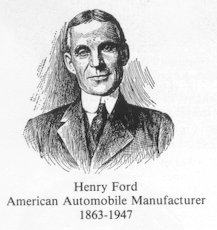Today, let's try to design an airplane. The University of Houston's College of Engineering presents this series about the machines that make our civilization run, and the people whose ingenuity created them.
As the clouds of WW-II gathered in 1941, our Air Force badly needed better planes, and lots of them. So the Air Force went to the automobile manufacturers for help. In 1941, General Motors started making B-29 parts, and Ford set up a plant to make B-24's at Willow Run. Then General Motors hired Don Berlin, the man who'd designed the P-40 -- that was the fighter plane the Flying Tigers had been using in China.
 Up to then airplanes had been almost hand-made. Historian I.B. Holley tells us that the biggest airplane company could turn out three planes a day, while automobile makers made three cars a minute. Henry Ford, for one, didn't appreciate how hard it was to adapt a good airplane design to his mass-production methods. He rashly claimed that, freed of government red tape, he'd be able to make more than a thousand planes a day.
Up to then airplanes had been almost hand-made. Historian I.B. Holley tells us that the biggest airplane company could turn out three planes a day, while automobile makers made three cars a minute. Henry Ford, for one, didn't appreciate how hard it was to adapt a good airplane design to his mass-production methods. He rashly claimed that, freed of government red tape, he'd be able to make more than a thousand planes a day.
So Don Berlin went to the Air Force with a plan that would link his skills as an airplane designer with General Motors's style of mass production. He showed them a new fighter-plane design. The plane, the XP-75, was supposed to outperform our experimental fighters. But he was going to avoid the problems these planes were giving us. His plan was simple. He'd use the best parts of other airplanes -- the wing of the P-40, the tail of the A-24, the landing gear of the P-47, and so on.
Like Pygmalion or the Frankenstein monster, the XP-75 was to be an assembly of perfect parts. Unfortunately, the result resembled Frankenstein's creation in more ways than one. It was an oversized monster that couldn't compete with planes designed from the ground up.
Yet, in its haste, the Air Force had gone ahead and tooled up to mass-produce this beast -- they were so sure it would succeed. When the whole thing was finally scrapped in 1944, it had cost over nine million dollars. That was still a huge chunk of the government budget back in 1944.
A designer must, after all, seek out the harmony of the many parts that make up a design. He must see the design whole. Sophia Loren once pointed out that all her parts were wrong. Her nose was the wrong shape, her mouth was too wide, and so on. Yet who could fault her beauty? In a good design, the components have to make sense in the context of the whole. Just as a Miss America contest, with its focus on components, never identifies really great beauty, the XP-75 was no more than a collection of fine parts. It wasn't a whole airplane.
I'm John Lienhard, at the University of Houston, where we're interested in the way inventive minds work.
(Theme music)
Holley, I. B., Jr., A Detroit Dream of Mass-Produced Fighter Aircraft: The XP-75 Fiasco. Technology and Culture, Vol. 28, No. 3, July 1987, pp. 578-593.
Yenne, B., The World's Worst Aircraft. New York; Barnes & Noble Books, 1987, pp.66-67.
This episode has been greatly revised as Episode 1438.
For specifications and photos of the XP-75, see the website, https://en.wikipedia.org/wiki/Fisher_P-75_Eagle